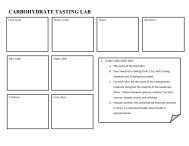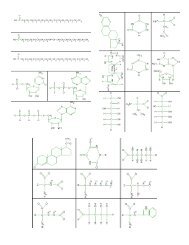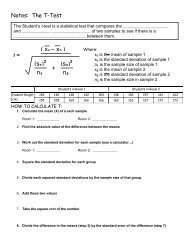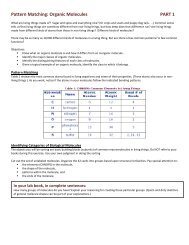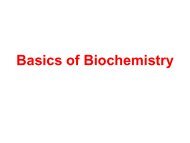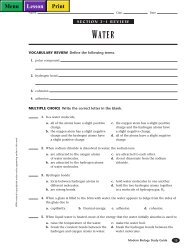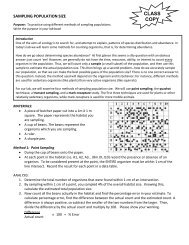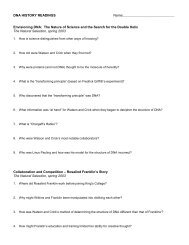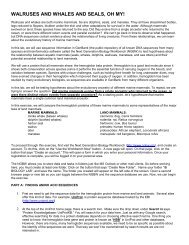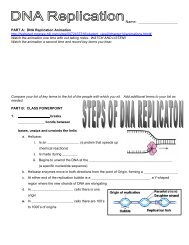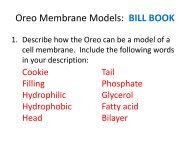HGP and gene identification - Biology for Life
HGP and gene identification - Biology for Life
HGP and gene identification - Biology for Life
- No tags were found...
You also want an ePaper? Increase the reach of your titles
YUMPU automatically turns print PDFs into web optimized ePapers that Google loves.
<strong>HGP</strong> <strong>and</strong> Gene IdentificationCLASS COPY!!!A <strong>gene</strong> is a relatively small section of DNA which encodes (provide a template <strong>for</strong>) a protein. Chromosomes are molecules thatconsist of a very long str<strong>and</strong> of DNA coiled many times, <strong>and</strong> proteins called histones which hold the whole structure together. Asingle chromosome has MANY <strong>gene</strong>s located on it. To put things very simply, chromosomes are made up of <strong>gene</strong>s <strong>and</strong> <strong>gene</strong>s aremade of DNA. One could use the analogy; DNA- letters, <strong>gene</strong>s-words, chromosomes-books, genome-collective volume.One of the major accomplishments of the Human Genome Project was the <strong>identification</strong> of <strong>gene</strong>s <strong>and</strong> where they are located on achromosome. The locus (plural loci) is the specific location of a <strong>gene</strong> or DNA sequence on a chromosome. The list of loci known<strong>for</strong> a particular genome is called a <strong>gene</strong>tic map. Gene mapping is the process of determining the locus <strong>for</strong> a particular biologicaltrait.The chromosomal locus of a <strong>gene</strong> might be written "6p21.3".6: The chromosome number.P: The position is on the chromosome's short arm (q indicates the long arm). The “arms” are the sides of thechromosome radiating from the centromere.21.3 The numbers that follow the letter represent the position on the arm: b<strong>and</strong> 2, section 1, sub-b<strong>and</strong> 3. The b<strong>and</strong>s arevisible under a microscope when the chromosome is suitably stained. Each of the b<strong>and</strong>s is numbered, beginningwith 1 <strong>for</strong> the b<strong>and</strong> nearest the centromere. Sub-b<strong>and</strong>s <strong>and</strong> sub-sub-b<strong>and</strong>s are visible at higher resolution.A range of locations is specified in a similar way. For example, the locus of <strong>gene</strong> OCA1 may be written "11q1.4-q2.1", meaning it ison the long arm of chromosome 11, somewhere in the range from sub-b<strong>and</strong> 4 of b<strong>and</strong> 1, <strong>and</strong> sub-b<strong>and</strong> 1of b<strong>and</strong> 2.ON IN YOUR LAB BOOK: Use complete sentences to define or explain:1. Gene:2. Chromosome:3. Locus:4. Genetic map:IN LAB BOOK5. 22q12.2
LOCATION OF GENETIC DISEASE GENES ON CHROMOSOMES1. Go to the NCBI homepage (http://www.ncbi.nlm.nih.gov/)2. In the left h<strong>and</strong> menu column, find <strong>and</strong> click on the link, “<strong>gene</strong>tics <strong>and</strong> medicine”3. Scroll down <strong>and</strong> click the link <strong>for</strong> “<strong>gene</strong>s <strong>and</strong> disease”4. From the contents list, select “chromosome map.”5. The resulting page has in<strong>for</strong>mation <strong>for</strong> each chromosome. In the table like the one shown below, fill in the number of bases <strong>and</strong> number of<strong>gene</strong>s found on the chromosome.6. From the map of the chromosome, select <strong>and</strong> record one of the major diseases listed. Also write the symbol <strong>for</strong> the <strong>gene</strong> (the codeabove the name of the disease)7. Click the name of the one disease you’ve selected <strong>for</strong> each chromosome. A separate page will open up that summarizes in<strong>for</strong>mation aboutthat disease. In the table, write one sentence to record the effects / symptoms of the disease you’ve selected.8. Go to http://genome.ucsc.edu/9. Click the link <strong>for</strong> “Genome Browser” on the left h<strong>and</strong> menu10. The resulting page shows the “genome Browser Gateway.” Be sure the clade is set to mammal, the genome is set to human, the assemblyis set to February 2009, <strong>and</strong> the position box is blank.11. In the box <strong>for</strong> “<strong>gene</strong>,” type the symbol of a <strong>gene</strong> you selected. Hit submit.12. Record the locus of the <strong>gene</strong> from the in<strong>for</strong>mation on the resulting page. Use the notation introduced above. For example, if the result says“chr 1 (p34.1)” you would record 1p34.1 into your data table.13. Repeat <strong>for</strong> each <strong>gene</strong> in your table.
ChromosomeNumber ofBase PairsNumberof GenesOne Major AssociatedDisease GeneGenesymbolLocus ofDisease GeneEffects/ Symptoms of Disease1.2.3.Example table… createone like it in your labbook. Include ALL 24chromosome types.X.Y.DIVERSITY OF GENOMES1. Return to the NCBI homepage.2. From the homepage, click the link <strong>for</strong> Taxonomy in the blue frame on the left h<strong>and</strong> side of the screen.3. On the resulting page, select Taxonomy under the “databases” heading.4. Create <strong>and</strong> fill in a table like the one below by filling in the scientific names of the 23 of the most commonly used organisms in molecularresearch.5. Click the link <strong>for</strong> each organism to find the common name. Record that name in your table.Scientific NameCommon NameDo ALL of yourtables have titles?



